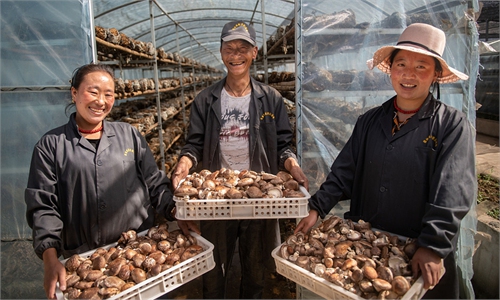How China deployed some of its most innovative business models to fight poverty
Characteristic tourism, internet and new policies help lift incomes in rural areas

A farmer displays newly-harvested pumpkins in Xujiaba Township, Sinan County of southwest China's Guizhou Province, Aug. 12, 2020. Guizhou, which used to be a provincial-level region with the biggest population of poor people, has lifted more than 9 million people out of poverty since 2012. (Xinhua/Yang Wenbin)
China has made remarkable achievements in lifting approximately 100 million people from poverty, a hard-won result of top-down policy support, nation-wide solidarity and commercial innovation.
From characteristic tourism to e-commerce to innovative lending, many business strategies and technological achievements have contributed to the mighty task.
In Northwest China's Xinjiang Uygur Autonomous Region, local officials help residents escape poverty with the help of abundant regional tourism resources, characteristic agriculture and animal husbandry.
Sataer Maimaiti, a 70-year-old villager in Aksu, Xinjiang has operated an "agritainment" resort with his wife since 2012. At first they saw almost no improvement, but the resort now offers jobs for impoverished households thanks to the local government's poverty alleviation measures.
"With publicity by the township government and rural committee, the number of visitors coming to our resort surged more than 100 percent during the peak season in September 2020," Maimaiti said, with bookings almost every day. At the resort, tourists can pick vegetables and fruits and enjoy home-made dishes.
Under the guidance of the local government, Maimaiti hires people from poverty-stricken households. The small resort provides long-term jobs to four registered poverty-stricken residents and seven non-impoverished residents.
China's popularization of mobile phones and the coverage of communication networks provide a window to make underprivileged rural areas known to the outside world.
Fiber-optic and 4G networks have reached more than 98 percent of villages across the country, and 5G has also been introduced into more rural areas, making it possible for poverty alleviation via livestreaming to take place, Hong Tao, director of the Institute of Business Economics at Beijing Technology and Business University, told the Global Times on Wednesday.
With the urbanization rate exceeding 50 percent, a large number of young people have returned to their hometowns to start businesses, making rural areas the driver of the future economy.
As a short video-sharing platform, Kuaishou contributes to the nation-wide poverty alleviation task through its livestreaming services. Kuaishou has launched a series of rural entrepreneurship incubation projects that empower participants on how to establish and run businesses, as well as provide data traffic and brand resources to encourage these participants to boost rural industry development and increase local employment to ease poverty.
Data sent by Kuaishou to the Global Times on Wednesday showed that it has supported more than 100 rural entrepreneurs and incubated 57 rural firms and cooperatives that offer about 1,200 jobs and help more than 10,000 households increase their incomes.
Wang Jiao and Gao Yulou are a couple who have led fellow villagers to make money on Kuaishou. They returned from the city to their hometown in Huaping, Southwest China's Yunnan Province and made a living by selling mangos via livestreaming on Kuaishou, and also by sharing food and special local products, according to Kuaishou's report.
This couple helped 80 local beekeepers' annual revenue increase by about 40,000 yuan ($6,204) by selling their honey via livestreaming, and they also helped more than 70 mango farmers increase their incomes.
The couple is seeking to establish a cooperative to build an agricultural product brand to promote the development of local mango harvests and special products.
As a significant part of the government efforts in digitalizing rural areas, more than 1,400 counties have participated in a national project of bringing e-commerce into rural areas from 2014-20, releasing the potential of rural consumption in the form of Internet Plus and promoting the rapid development of livestreaming sales, Hong said.
He said that livestreaming has enabled people in remote areas to receive higher education via online training courses, with instructors from higher education institutions in big cities.
In a small mountain village called Daditou in Liupanshui, Southwest China's Guizhou Province, Xu Wenyong established a specialized farming cooperative on a remote mountain with altitudes of up to 1,600 meters, thanks to favorable loan policies offered by commercial banks to help underprivileged regions.
In November 2017, the cooperative received a loan of 3.4 million yuan with an interest rate of 4.7 percent from Agricultural Bank of China. The rate was about 3 percentage points lower than the general interest rate for loans to rural communities, Xu said.
With the loan, Xu bought 100 cattle and helped 34 families, including 17 extremely poor ones, get out of poverty.
"Three long-term workers at our cooperative have seen their annual incomes rise about 20,000-30,000 yuan from what they earned before working here, while many temporary workers also see income growth," Xu said, noting that he will lead the community to consolidate the fruits of the poverty-alleviation drive in line with national policies.



